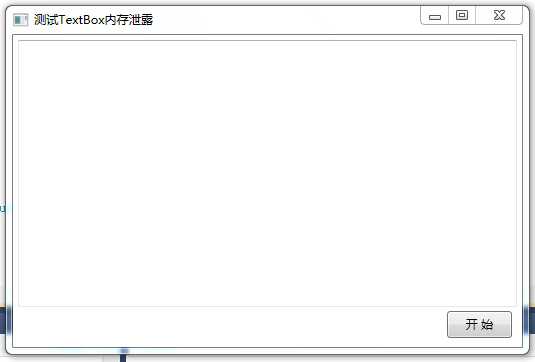标签:
前段时间参与了一个WPF编写的项目,在该项目中有这样一个场景:在程序运行过程中需要动态地产生大量文本信息,并追加WPF界面上的一个TextBox的Text中进行显示。编写完之后,运行该项目的程序,发现在产生大量信息之后,发现系统变慢了,打开任务管理器才发现,该项目的程序占用了将近1.5G的内存(天啊!!!这不是一般的耗内存啊!!!)。后来通过查资料和探索才发现了WPF的TextBox在追加Text显示文本时会造成内存泄露。下面通过一个小Demo程序来展示一下这个内存泄露。
我的Demo程序很简单,就是在界面上显示一个TextBox和一个Button,点击Button后就从0到9999进行for循环并将这些数字追加的TextBox的Text中进行显示。代码如下,

MainWindow.xaml <Window x:Class="TextBoxMemoryLeak.MainWindow" xmlns="http://schemas.microsoft.com/winfx/2006/xaml/presentation" xmlns:x="http://schemas.microsoft.com/winfx/2006/xaml" Title="测试TextBox内存泄露" Height="350" Width="525" WindowStartupLocation="CenterScreen"> <Grid Margin="5"> <Grid.RowDefinitions> <RowDefinition Height="*" /> <RowDefinition Height="35" /> </Grid.RowDefinitions> <DockPanel Grid.Row="0"> <TextBox Name="tbOutput" IsReadOnly="True" VerticalScrollBarVisibility="Auto"/> </DockPanel> <StackPanel Grid.Row="1" FlowDirection="RightToLeft" Orientation="Horizontal"> <Button Name="btnStart" Content="开 始" Margin="5,4,5,4" Width="65" Click="btnStart_Click" /> </StackPanel> </Grid> </Window>

MainWindow.xaml.cs using System; using System.Collections.Generic; using System.Linq; using System.Text; using System.Windows; using System.Windows.Controls; using System.Windows.Data; using System.Windows.Documents; using System.Windows.Input; using System.Windows.Media; using System.Windows.Media.Imaging; using System.Windows.Navigation; using System.Windows.Shapes; namespace TextBoxMemoryLeak { /// <summary> /// MainWindow.xaml 的交互逻辑 /// </summary> public partial class MainWindow : Window { public MainWindow() { InitializeComponent(); } private void btnStart_Click(object sender, RoutedEventArgs e) { this.btnStart.IsEnabled = false; this.tbOutput.Text = ""; for (int i = 0; i < 10000; i++) { //使用此语句进行Textbox的追加会造成内存泄露 //this.tbOutput.Text += string.Format("{0}\n", i); //使用此语句进行Textbox的追加可避免内存泄露 this.tbOutput.AppendText(string.Format("{0}\n", i)); } this.btnStart.IsEnabled = true; } } }
界面如下所示:

最初我们采用的是TextBox的Text追加方式如下
this.tbOutput.Text += string.Format("{0}\n", i);
构建,启动调试后,我们查看任务管理器,此时所占内存只有16M,

点击【开始】按钮之后,等到从0输出到9999之后,我们再查看任务管理器,发现此时所占的内存飙到了600+M,

若此时再点击【开始】按钮,等循环结束,发现所占内存飙到了900+M,

再点击【开始】按钮的话,就要发生OutOfMemory异常的。当我们将循环改为从0到19999时,第一次点击【开始】按钮,我的机器就发生OutOfMemory异常了。
将TextBox的Text追加方式改为下面语句
this.tbOutput.AppendText(string.Format("{0}\n", i));
构建,启动调试,然后点击界面的【开始】按钮,等循环结束,我们查看任务管理器,测试Demo程序只占了29M内存(此时是从0到19999的循环)。

标签:
原文地址:http://www.cnblogs.com/tianciliangen/p/5037958.html